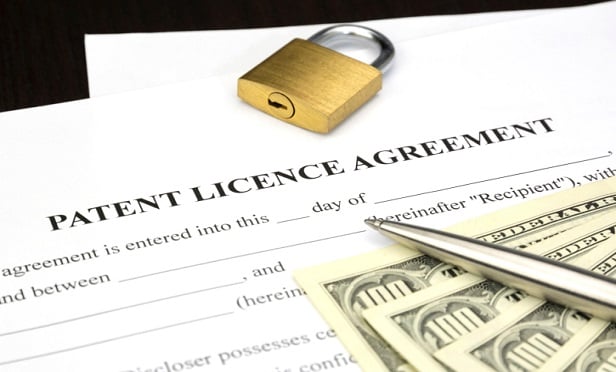Features

Exploring the Nebulous Boundaries of Trade Dress
Now that we are in the digital age, questions have been raised about the trade dress of websites and apps.
Features

Damages for Extraterritorial Infringement of U.S. Patents
A look at the gray area of infringement of U.S. patents in the U.S., but with related consequences or actions outside the U.S.
Features

Rights and Obligations In Patent Licenses
The owner of a commercially successful patent may have competing desires. On one hand, the patent owner wants to protect the patent and secure its maximum benefit; on the other hand, the patent owner wants to avoid enforcement litigation with competitors because it is expensive and puts the patent at risk.
Features

Did Congress Create Unintended Risks to Innovators In the AIA?
Many observers greeted the passage of the AIA into law as a long-overdue overhaul of U.S. patent law that aligned it with patent systems prevailing in the rest of the world. Who knew what mischief just seven of the AIA's more than 25,000 words contained? The U.S. Supreme Court answered earlier this year.
Features

Takeaways from the Recent Qualcomm Decision
The DOJ's intervention, and the judge's ultimate decision, has exposed tensions between the DOJ and FTC, and within the FTC itself, and public scrutiny is far from over as the case heads to the Ninth Circuit on appeal.
Features

States Not Immune from PTAB Proceedings, Federal Circuit Rules
Fifteen states had argued that they and their public universities shouldn't have to expose their patents to validity review at the patent trial and appeal board.
Columns & Departments

IP News
Federal Circuit Finds District Court Erred in Analysis of Motivation to Combine Prior Art References, Yet Affirms Ultimate Conclusion of Non-obviousness Due to the Lack of a Reasonable Expectation of Success<br>Federal Circuit Rules that Issue Preclusion Bars a Party from Arguing in an Appeal of an Inter Partes Review Decision an Issue Previously Decided in Another Inter Partes Review Proceeding that Was Not Appealed
Features

As Section 101 and the Progeny of Mayo and Myriad Continue to Wreak Havoc on Portfolios, How Is The Life Sciences Industry Fighting Back?
Since the U.S. Supreme Court decided Mayo and Myriad, the Federal Circuit has expanded the holdings and invalidated more patents directed to biological discoveries. If the newly discovered correlations and properties of what is found in nature cannot be patented, what strategies for protection are left for companies doing biological research?
Features

IPR Estoppel: The Present and the Future
IPRs have now been conducted for several years, and litigation has ensued over the procedures by which they are conducted. Decisions have been rendered by the U.S. Supreme Court and the U.S. Court of Appeals for the Federal Circuit, which have resolved some issues, created others, and altered procedures.
Columns & Departments

IP News
Federal Circuit Declines to Follow Patent Office's Subject Matter Eligibility Guidance In Affirming Trial Court's Decision That Claims Are Directed to Patent-Ineligible Subject Matter
Need Help?
- Prefer an IP authenticated environment? Request a transition or call 800-756-8993.
- Need other assistance? email Customer Service or call 1-877-256-2472.
MOST POPULAR STORIES
- Bankruptcy Sales: Finding a Diamond In the RoughThere is no efficient market for the sale of bankruptcy assets. Inefficient markets yield a transactional drag, potentially dampening the ability of debtors and trustees to maximize value for creditors. This article identifies ways in which investors may more easily discover bankruptcy asset sales.Read More ›
- Judge Rules Shaquille O'Neal Will Face Securities Lawsuit for Promotion, Sale of NFTsA federal district court in Miami, FL, has ruled that former National Basketball Association star Shaquille O'Neal will have to face a lawsuit over his promotion of unregistered securities in the form of cryptocurrency tokens and that he was a "seller" of these unregistered securities.Read More ›
- Compliance Officers and Law Enforcement: Friends or Foes?<b><i>Part Two of a Two-Part Article</b></i><p>As we saw in Part One, regulators have recently shown a tendency to focus on compliance officers who they deem to have failed to ensure that the compliance and anti-money laundering (AML) programs that they oversee adequately prevented corporate wrongdoing, and there are several indications that regulators will continue to target compliance officers in 2018 in actions focused on Bank Secrecy Act/AML compliance.Read More ›
- Structuring Strategies for Off-Balance-Sheet Treatment of Real Property LeasesThe Financial Accounting Standards Board released a new set of lease accounting standards, ASC 842, which went into effect earlier this year. Most significantly, publicly traded companies are now obligated to list all leases of 12 months or longer on their balance sheets as both assets and liabilities. Large private companies will follow suit in 2020.Read More ›
- Artist Challenges Copyright Office Refusal to Register Award-Winning AI-Assisted WorkCopyright law has long struggled to keep pace with advances in technology, and the debate around the copyrightability of AI-assisted works is no exception. At issue is the human authorship requirement: the principle that a work must have a human author to be eligible for copyright protection. While the Copyright Office has previously cited this "bedrock requirement of copyright" to reject registrations, recent decisions have focused on the role of human authorship in the context of AI.Read More ›
